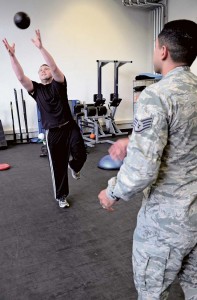Despite how cautious a service member may be, they still run the risk of sustaining an injury through everyday physical activity, whether it’s on the job, while working out or while playing a sport. If they become injured, it can be a journey to get them fit to fight again.
However, the journey doesn’t have to be taken alone. Airmen with the 86th Medical Operations Squadron Physical Therapy Clinic are there to help along the way.

“It is important for people to come see us after an injury,” said Staff Sgt. Mario Jimenez, 86th MDOS physical therapy technician. “Without the proper healing or treatment, they run the chance of an injury becoming worse.”
The 86th MDOS Physical Therapy Clinic can see active-duty patients for a variety of neuromuscular injuries, such as sprains, strains, an assortment of limb pain, rehab after the healing of a fracture, motor vehicle accidents, torn tendons and ligaments, post-surgery repairs, and many more.
“First, the patient will go see the doctor — the actual physical therapist,” Jimenez said. “The therapist will test their muscles and assess the situation. Then, they will come up with a treatment plan consisting of either exercises or modality, such as contraction, ice, heat or electrical stimulation. From that plan, they schedule more appointments to see the technicians, and we implement.”
The clinic averages between 200 to 250 physical therapy sessions per week with sessions lasting anywhere from 30 to 90 minutes.
“For here, our therapists like to have the patients in at least a few times a week for three to four weeks,” Jimenez said. “Then, they will do a re-evaluation.”
The re-evaluation determines how far a patient has come since the initial assessment of the injury as well as further steps the physical therapists and technicians will take from that point on.
Though it can be crucial for service members’ healing to be seen by physical therapists and technicians, patients should not just show up to the clinic unannounced.
“There are a number of ways for patients to be seen,” said Master Sgt. Antwionett Wheeler, 86th MDOS Physical Therapy flight chief. “They can go to their primary care manager or their personal doctor. The doctor will refer them over by putting in a consult for physical therapy. They can also get a referral from another specialty clinic, such as orthopedics or podiatry, to come see physical therapy.”
Patients can also help themselves by taking steps to minimize further damage after they have been injured, Jimenez said.
“For example when someone sprains his ankle, they need to R.I.C.E — rest, ice, compress and elevate — until they start feeling better or can get proper medical care,” Jimenez said.
Without the proper precautions and physical therapy after an injury, service members run the risk of repeating the injury and causing greater damage to the area.
“I love my job as a physical therapy technician,” Jimenez said. “I enjoy the satisfaction of helping others return to the activities they enjoy doing.”
So, regardless of how an injury occurred, the Airmen with the 86th MDOS Physical Therapy Clinic are there to help service members get fit to fight once more.


